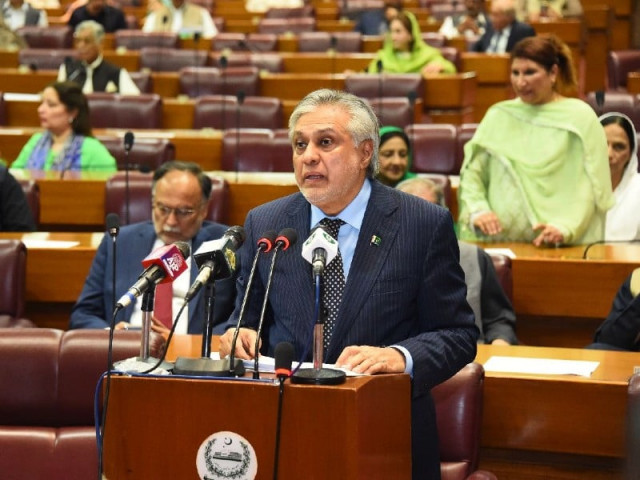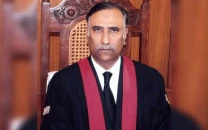Govt bets on relief, amnesty
Bloated outlay of Rs14.5tr contains Rs7.6tr deficit; Dar terms bill fiscally responsible; rules out new IMF programme

Finance Minister Ishaq Dar on Friday unveiled a Rs14.5 trillion bloated budget, with the highest-ever deficit of Rs7.6 trillion in a bid to appease nearly a dozen sectors ahead of the general elections that could antagonise the International Monetary Fund (IMF).
The budget for fiscal year 2023-24 appears to be promoting an informal economy at the expense of the formal sectors and places heavy reliance on bilateral creditors – Saudi Arabia, China and the United Arab Emirates – to fund the expenses.
The measures like an amnesty scheme for legalising $100,000 or Rs29 million in black money and a 0.6% tax on cash withdrawals would encourage the informal economy and increase currency in circulation.
Dar loaded the budget with tax relief and subsidies for nearly a dozen sectors, including 30% increase in salaries of officers and 35% for employees of Grade-1 to Grade-16. He has also announced a 17.5% increase in pensions, besides setting the minimum wage at Rs32,000.
Unveiling the budget in the National Assembly, Dar stressed that “the next fiscal year’s budget will not be an election year budget, rather it is a fiscally responsible budget”. He went on to say that “no independent analyst could say otherwise”.
The details, however, showed that the government had announced Rs80 billion for the Prime Minister’s Package, Rs90 billion for parliamentarians’ schemes and Rs50 billion for the provincial nature projects.
The finance minister proposed tax reduction for the Information Technology sector, listed companies, overseas Pakistanis, young entrepreneurs and giving relief to the builders and traders. He also extended the tax-free status of the erstwhile Federally Administered Tribal Areas.
Dar said that owing to the rupee devaluation and an increase in the State Bank of Pakistan’s (SBP) policy rate, people faced problems, but “we sacrificed our political gains for improving the economy”.
The budget documents showed that the government did not have any hope that the IMF programme would revive. It had not booked the $2 billion Saudi Arabian additional loan and the $1 billion UAE new loan against the receipts for this fiscal year. Instead the loans are shown as part of the next fiscal year’s receipts.
The IMF had set the condition of arranging $6 billion additional loans to qualify for the staff-level agreement. The finance minister said that the IMF programme was a priority of the government and it was fully trying to revive it before the end of June.
Interestingly, the government showed $2.4 billion IMF loan receipts in the next fiscal year, despite the programme ending on June 30. Dar has already ruled out talks for any new programme by this government.
The government has also budgeted $1.5 billion Eurobond and $4.5 billion in new foreign commercial loans in the next fiscal year.
In his budget speech, Dar claimed that no new tax had been imposed in the next fiscal year. But the Finance Bill, 2023 showed that the government had introduced a 50% windfall profit tax, 0.6% withholding tax on cash withdrawals, 10% to 20% tax on bonus shares and Rs200,000 tax on every foreign worker working in Pakistan.
The government proposed gross Rs233 billion new taxes, excluding the impact of the bonus shares and the 50% tax on windfall profits.
While unveiling the second budget of the coalition government in an unusually calm atmosphere, Dar also increased taxes on second-hand imported cars. He increased the tax on credit card users by 400% on making payments of overseas purchases like Netflix, data storages and paying for Twitter services.
Dar unveiled a fiscally expansionary budget of Rs14.5 trillion – an unprecedented 50% increase over this year’s approved budget – mainly on account of record high interest payments.
For fiscal year 2023-24, the budget deficit – gap between expenses and the income – was estimated at 7.2% of the gross domestic product (GDP). This was quite large and in absolute terms was equal to Rs7.6 trillion, according to the budget documents.
Alarmingly, half of the bloated budget outlay would be earmarked for paying the interest cost. After adding defence outlay of Rs2.7 trillion and Rs7.3 trillion interest payments, the federal government will spend Rs10 trillion or 69% of the budget on them and their related functions.
The stated defence budget is Rs1.809 trillion as against the demand of Rs1.922 trillion. In addition to that, the government had given Rs563 billion for military pensions and Rs280 billion for the armed forces development programme.
Sources said that the Rs7.3 trillion debt servicing cost was on the lower end and was also less than the estimates of the IMF that it shared with the finance ministry. The allocations for the interest payments were shown at Rs7.3 trillion – higher by Rs3.4 trillion or 84% against this year’s approved budget.
The central bank has significantly increased the interest rates to 21% and as a result, half of next fiscal year’s balloon budget would be consumed on these payments. The rupee devaluation was another factor behind record interest payments. Of Rs7.3 trillion, the external debt servicing was estimated at Rs872 billion.
The overall primary budget was shown positive by 0.4% of the GDP on the back of provincial cash surpluses of Rs650 billion. The overall budget deficit had been proposed at 6.5% of GDP or Rs6.9 trillion.
The sources said that some late-night changes were made in the budget aimed at showing the overall primary surplus of 0.4% of the GDP or Rs379 billion. The figures of grants, subsidies, and the army’s development programme were lowered at the eleventh hour, they added.
It appears that the finance ministry’s estimates have lost credibility, as the budget estimates for the outgoing fiscal year agreed with the IMF just in February were different from those reported on Friday.
The budget figures suggested that the IMF might not endorse such an expansionary fiscal outlay, which would further contribute to the overall debt burden of the country.
The subsidies’ allocation had been announced at Rs1.070 trillion –down from Rs1.125 trillion that the finance ministry originally wanted to give for the next fiscal year. An amount of Rs1.464 trillion was given in grants, roughly Rs60 billion less than the initially estimated figure.
To run the civil government, an amount of Rs714 billion had been proposed, while Rs761 billion was set aside for the payment of pensions, including military’s.
The gross federal government revenues were estimated at Rs12.2 trillion. After paying the shares of the provinces, the net revenues of the federal government had been projected at Rs6.9 trillion –Rs400 billion less than the downward projected cost of debt servicing for the next fiscal year.
The FBR’s tax target was projected at Rs9.2 trillion—up by 28% over the revised estimates. But in terms of size of the GDP, it was equal to only 8.7% and not enough to contain the growing public debt and finance the expenses.
The government proposed Rs2.96 trillion non-tax revenues, largely to be collected from the central bank and on account of petroleum levy. The central bank’s profit was estimated at Rs1.13 trillion while the petroleum levy collection was estimated at Rs869 billion.
Dar said that the government expected the economy to grow by 3.5%, whereas the target for exports in the next fiscal year was $30 billion. He added that the overseas Pakistanis’ remittances equalled to 90% of the exports. The government expected them to send $33 billion in FY24.
He said that the tax on overseas Pakistanis for investment in immovable property was proposed to be removed. They would also be provided fast-track immigration facility at the airports.



















COMMENTS
Comments are moderated and generally will be posted if they are on-topic and not abusive.
For more information, please see our Comments FAQ